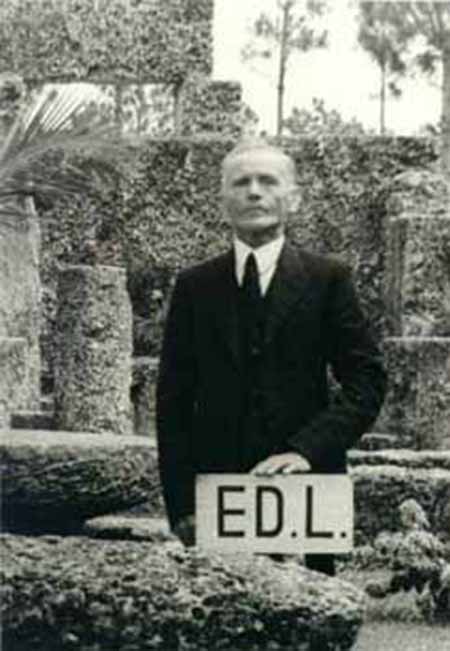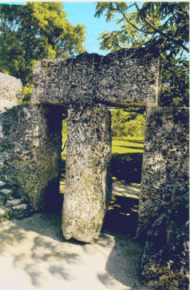Coral Castle was built in the early 20th century by an eccentric Latvian recluse named Edward Leedskalnin - who supposedly left Latvia when he was rejected by his 16 year old fiance. He would never marry - and would spend 30 years of his life building a Coral Castle - and surrounding buildings - for his supposed 'Sweet Sixteen'.
Edward Leedskalnin was a 100 pound - 5 foot tall man - who wound up in Homestead, Florida - on a ten-acre tract of land just south of Miami, Florida. Somehow he managed to single-handedly lift and maneuver blocks of coral weighing up to 30 tons each and create not only a castle but other things. How Edward did his work - has never been discovered - though he labored for 30 years.
He worked alone - at night - and seemed to know when he was being watched. On those occasions - he never lifted any of the stones.
Many articles claim that he found the same secrets of levitation as those used by the supposed builders of the Pyramids of Egypt - among other megalithic sites around the world whose creation remain unexplained.
Edward Leedskalnin was quoted as saying, "I have discovered the secrets of the pyramids, and have found out how the Egyptians and the ancient builders in Peru, Yucatan, and Asia, with only primitive tools, raised and set in place blocks of stone weighing many tons!"
In total, Edward quarried over eleven hundred tons of coral rock for his castle, using tools fashioned from wrecking-yard junk, never revealing how he managed to rise, and position, the massive coral blocks that make up the compound. An air of mystery surrounded his two story monolith, known as the tower, which housed his workshop and living quarters which no one was permitted to enter. He was secretive, and almost always worked at night, no one ever saw him.
Leedskalnin was a student of the universe. Within his castle walls, built of coral blocks weighing approximately 15 tons each, he had a 22-ton obelisk, a 22-ton moon block, a 23-ton Jupiter block, a Saturn block, a 9-ton gate, a rocking chair that weighed 3-tons, and numerous puzzles. A huge 30-ton block, which he considered to be his major achievement, he crowned with a gable shaped rock. These personal accomplishments have astounded and surprised many engineers and technologists, who compare them with those achieved by workers handling similar weights in industry today.
Much of the Coral Castle site is calibrated to celestial alignments, including an ingenious thirty ton telescope, towering twenty five feet above the complex, perfectly aligned to the North Star. A working sundial, calibrated to noon of the Winter and Summer Solstice, is so accurate it tells time within two minutes!
Edward Leedskalnin's Celestial Telescope
An area known as the 'moon pond,' comprised of three 18-ton pieces of coral, represents the first quarter, last quarter, and the full moon. Nearby stand Mars (which Ed believed sustained life), and a ringed Saturn - each the size of an automobile. An obelisk taller then the great monolith at Stonehenge, stretches 40' toward the sky, weighing 57,000 pounds! A series of concentric coral circles is said to represent the solar system.
Entrance to Coral Castle is made through a gate fashioned from a single coral block weighing nine tons. This miraculous monolith is approximately 80 inches wide, 92 inches tall, and 21 inches thick. It fits within a quarter of an inch of the walls on either side and pivots through an iron rod resting on an automobile gear. The enormous block balances so perfectly on its center of gravity that a visitor can easily push it open with one finger.
People who are sensitive to electromagnetic energies fields will sometimes report headaches while standing inside the archway of the nine-ton swinging gate - door - thought to be over a vortex - and a major grid point of the planet.
Another gate, this one a great triangle,
at the opposite wall, weighs three tons.
Is that a triangle . . . as in pyramid energies . . . ?
Coral Castle's megalithic renderings of planets and moons.
t
Ed carved this giant heart.
Was he referencing the heart chakra and feminine energies?
A 5,000 pound heart-shaped coral rock table, with a red blooming ixora growing from its center, is believed to be the world's largest valentine, according to Ripley's Believe It Or Not.
Inside the courtyard, to the immediate right, rears a broad, square tower, with a flight of stone steps ascending to a single doorway near the top. They lead to the highest point in the area and a small room. This chamber is occupied only by a leather hammock and a crude wooden table piled with primitive tools - chains, saws, many kinds of drills, wedges, hammers, chisels and crowbars. Tools also festoon the walls. This imposing tower was raised with approximately 243 tons of coral cut into cyclopean blocks weighing from four to nine tons each.
Edward Leedskalnin disputed contemporary science and believed all matter consisted of magnets which could produce measurable phenomena, and electricity. Ed would say he had rediscovered the laws of weight, measurement, and leverage" and that these concepts involved the relationship of the Earth to celestial alignments. He claimed to see beads of light which he believed to be the physical presence of nature's magnetism and life force, or what we term today, Chi.
Many people report that he used harmonics combined with grid energies and celestial alignments to do his work. Harmonics can be used to lift objects. Tibetan Monks combine their harmonics to elevate heavy objects.
'Tibetan Sound Levitation Of Large Stones Witnessed By Scientist'. In his work Diamagnetic Gravity Vortexes, found in the book Anti-Gravity and The World Grid David Hatcher Childress, postulates that the area of South Florida at Coral Castle (considered part of the Bermuda Triangle) is a powerful diamagnetic levitator. Leedskalnin demonstrated magnetism (EM energies), and the mechanism of levitation, by applying the natural Earth Grid principles of diamagnetism. Leedskalnin could levitate huge pieces of coral by using the center of mass for the needed slight, uplift, launching pressure.
Ed Leedskalnin showed every indication of being a natural geomancer - one who senses the unique telluric forces of the Earth. He was highly intuitive, and knew how to observe nature for signs of anomaly. This ultimately led him to the discovery of vortex energy, and the ability to harness the natural elements of magnetism.
He understood the critical nature of identifying the most energetic location to erect his massive Castle, and seemed to have known the secrets of anti-gravity, and its relation to cosmic events. Ed proceeded to develop a means of leverage power generated from the geomagnetic grid, and produced a system to generate anti-gravity waves.
Edward's notebooks are laden with schematics for magnetism, and electrical experiments. Although he possessed only a fourth-grade education, it seems he had discovered a means to reduce the gravitational pull of the earth. He wrote a series of pamphlets which included his theories on magnetism and cosmic force.
Researchers have speculated that Ed learned the secret of levitation, and one theory in particular caught the imagination of many. The planetary grid hypothesis postulates that the earth is covered by an invisible web of energy, which is concentrated at points of telluric power, the convergence of which create unusual phenomena.
These telluric grid dynamics played a vital role in the construction of the Castle, according to author Ray Stoner. In his book The Enigma of Coral Castle, Stoner speculates that the complex was originally moved from Florida City to Homestead, not because of privacy issues (as most historians suggest), but because Ed realized he had made a mathematical error in his original positioning, and moved the entire structure to take advantage of an area with greater telluric force.
In December of 1951 Ed Leedskalnin at age 64 became ill. He put a sign on the door saying 'Going to the Hospital'. He took a bus to Jackson Memorial Hospital in Miami. Three days later he died in his sleep of malnutrition and kidney failure, taking his secrets with him. After his death, $3,500 was found in the tower; his life savings, mostly from land sales.









